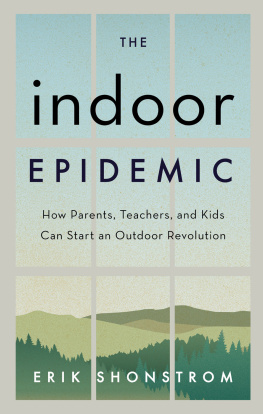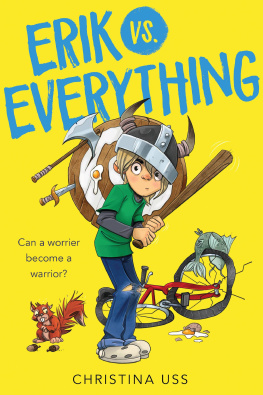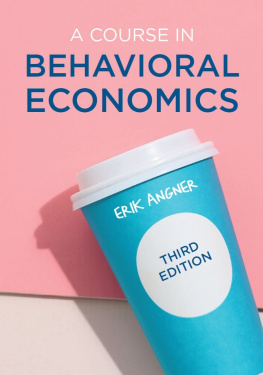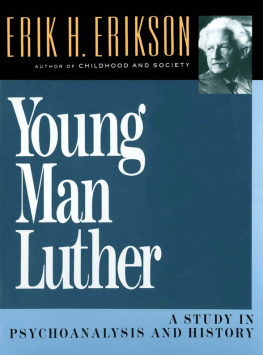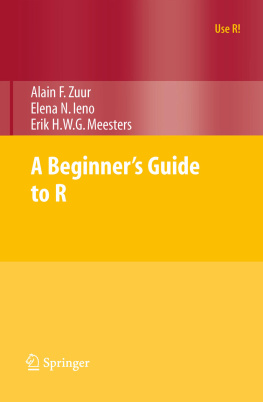Erik Shonstrom - The Indoor Epidemic
Here you can read online Erik Shonstrom - The Indoor Epidemic full text of the book (entire story) in english for free. Download pdf and epub, get meaning, cover and reviews about this ebook. year: 2021, publisher: Rowman & Littlefield Publishers, genre: Romance novel. Description of the work, (preface) as well as reviews are available. Best literature library LitArk.com created for fans of good reading and offers a wide selection of genres:
Romance novel
Science fiction
Adventure
Detective
Science
History
Home and family
Prose
Art
Politics
Computer
Non-fiction
Religion
Business
Children
Humor
Choose a favorite category and find really read worthwhile books. Enjoy immersion in the world of imagination, feel the emotions of the characters or learn something new for yourself, make an fascinating discovery.
- Book:The Indoor Epidemic
- Author:
- Publisher:Rowman & Littlefield Publishers
- Genre:
- Year:2021
- Rating:3 / 5
- Favourites:Add to favourites
- Your mark:
- 60
- 1
- 2
- 3
- 4
- 5
The Indoor Epidemic: summary, description and annotation
We offer to read an annotation, description, summary or preface (depends on what the author of the book "The Indoor Epidemic" wrote himself). If you haven't found the necessary information about the book — write in the comments, we will try to find it.
The Indoor Epidemic — read online for free the complete book (whole text) full work
Below is the text of the book, divided by pages. System saving the place of the last page read, allows you to conveniently read the book "The Indoor Epidemic" online for free, without having to search again every time where you left off. Put a bookmark, and you can go to the page where you finished reading at any time.
Font size:
Interval:
Bookmark:

Praise for The Indoor Epidemic
In The Indoor Epidemic, Erik Shonstrom has reminded us of a basic truth that every traveler knows: learning occurs through experience, and the best experiences are those that happen when we venture out into the wide world.
Rolf Potts, travel writer; author of Vagabonding and Marco Polo Didnt Go There
In an era of standards-based education within a technology-obsessed culture, Shonstrom reminds us of the educational value that lies just beyond our classroom cages, in our own backyards and beyond. This rich research-based text will inspire any thoughtful educator or parent to empower young people to move and engage with the natural world around them.
Donna Terrell, educator, Hillsborough County, Florida
Inactivity is killing Americans. Humans werent designed to sit at desks all day, and most of us started sitting at a desk in kindergarten. Shonstrom tackles not only the health consequences of our indoor epidemic, but also its effects on our intellectual ability and spiritual well-being. He uses science, literature, and personal experience to argue that it all begins with an institutionalized educational system in need of change. I didnt agree with every opinion in the book, but The Indoor Epidemic definitely challenged my ideas of traditional education and made me rethink my beliefs.
Paul W. Slavik, MD; hospitalist, internal medicine; assistant professor, University of Vermont College of Medicine
Published by Rowman & Littlefield
A wholly owned subsidiary of The Rowman & Littlefield Publishing Group, Inc.
4501 Forbes Boulevard, Suite 200, Lanham, Maryland 20706
www.rowman.com
Unit A, Whitacre Mews, 2634 Stannary Street, London SE11 4AB
Copyright 2017 by Erik Shonstrom
All rights reserved. No part of this book may be reproduced in any form or by any electronic or mechanical means, including information storage and retrieval systems, without written permission from the publisher, except by a reviewer who may quote passages in a review.
British Library Cataloguing in Publication Information Available
Library of Congress Cataloging-in-Publication Data Available
ISBN: 978-1-4758-2590-9 (cloth : alk. paper)
ISBN: 978-1-4758-2592-3 (electronic)
 The paper used in this publication meets the minimum requirements of American National Standard for Information SciencesPermanence of Paper for Printed Library Materials, ANSI/NISO Z39.481992.
The paper used in this publication meets the minimum requirements of American National Standard for Information SciencesPermanence of Paper for Printed Library Materials, ANSI/NISO Z39.481992.
Printed in the United States of America
This book is dedicated
with love and gratitude
to my kids, Vivien and Finn
theres no mountain
I wouldnt climb for you.
Many thanks to Sarah Jubar, my editor at Rowman & Littlefield, who has supported and promoted the ideas in this book from the start. Thanks also to Meredith Nelson and Savitha Jayakumar for their hard work and attention to detail. My gratitude goes as well to Rashad Shabazz, John Bodley, Paul Jones, and Paul Andrews, folks who kindly gave me their time and expertise. Im also indebted to Adam Rosenblatt, who elucidated childrens right to play outside for methanks, Ad. I owe so much to the kind, patient folks who looked at chunks of this manuscript and were kind enough to talk about some of the ideas in these pages; gratitude is due to Brian Murphy, Jeff Rettew, and Dave Mills. Im thankful to my family for the love theyve shown me over the years, especially my father Mike Shonstrom, and stepmother, Amy, whove made the trek into northern Vermont time and again to show their support. My kidsFinn and Vivienare the center of my world. I love you two past the horizon and back. Everything about my life that Im grateful for eventually leads back to one person: my wife, Cindy. Whenever I am unsure of myselfin prose, profession, or personalityI know that shell steer me straight, using the keen compass of her insight and the strength of her resolute honesty. Love you, Ghani.
What happens to us when we step over the threshold and head into the outdoors? Its a question thats puzzled me my whole life. Its hard to deny that there is something that happensa certain feeling, a particular frame of mindwhich we encounter in the open air versus within four walls. As the English writer Geoff Dyer once noted: I realised I could never experience a sense of spiritual arrival indoors.
Personally, I am intensely drawn to the outdoorsI feel a fierce urgency, every day, to get out there. As a teacher, Ive projected this need onto my students, and as a result my teaching philosophy has largely been concerned with creating outdoor and experiential education events, trips, and journeys. This book, while written over the course of a year or two, represents a lifetime of embracing the outdoors as a multitude of metaphors in my life: freedom, escape, sustenance, learning, and, honestly, the very stuff of meaning. Ive spent what is probably an unusual amount of time musing on the way in which we interact with the outdoors, and the way the outdoors enacts itself on us.
Its clich, but I feel more alive outdoors. Once, when I crossed paths with a bear on a hike in the Sierras, I was filled with a sense of immense gratitude, awe, joy, and old-fashioned happiness. There was shorts-soiling fear too, but mostly I felt alive.
Often, when reading about the experience of the wilderness, writers try to find their way into some sense of transcendence. I certainly agree, but in my experience it is a peculiar type of transcendence. I certainly dont transcend my sorry, physical state; I feel every blister, scratch, and bug bite acutely. But in these moments, as I feel my body moving through space, Im in direct communion with the very machinery of my beinglungs chuffing, heart thumping, muscles aching. My eyes wander, as does my mind. I am more in myself in these moments. If there is any transcendence, it is that I transcend the annoying realities of the institutionalized, codified, cataloged world.
In daily, civilized, indoor life, I become susceptible to petty jealousies, deceptive behavior, and anxiety-ridden rumination. But out there, I improveIm clearer, more focused in a cosmic sense by being less focused on the trivial. By any moral standard, or for that matter any calibration of personality and temperament, Im a better person in nature.
In my limited experience, most students are, too. And as a teacher, thats what I have worked at to provide for my students: the chance to be better people. Thats the opportunity I believe they have in the wild. Every kid deserves adventure, and the chance to be a hero.
Thats a roundabout way of introducing part of the impetus behind this book. I think kids are their best selves when theyre away from the atrophying succor of digital distraction. I think theyre better away from the civilized world of adults thats at times fed by our own neurosis and insipid, fear and ego-based rationales and rules. Some of what we make children do in education, when looked at with clear eyes, is absurd, and may in fact inhibit learning. As Rousseau states in Emile, I see nothing more stupid than these children who have been reasoned with so much.
We care about things that kids dont, but try to make them care, too, instead of trying to understand their values and wants. Weve developed baseless means to assess competencies and calibrate student success through outdated and imprecise ideologies. We give minority students, children from challenged socioeconomic backgrounds, and diverse learners short shrift sometimes. Not all the time, but often enough that it makes sense to explore what the outdoors can do to mitigate some of these challenges.
Font size:
Interval:
Bookmark:
Similar books «The Indoor Epidemic»
Look at similar books to The Indoor Epidemic. We have selected literature similar in name and meaning in the hope of providing readers with more options to find new, interesting, not yet read works.
Discussion, reviews of the book The Indoor Epidemic and just readers' own opinions. Leave your comments, write what you think about the work, its meaning or the main characters. Specify what exactly you liked and what you didn't like, and why you think so.

